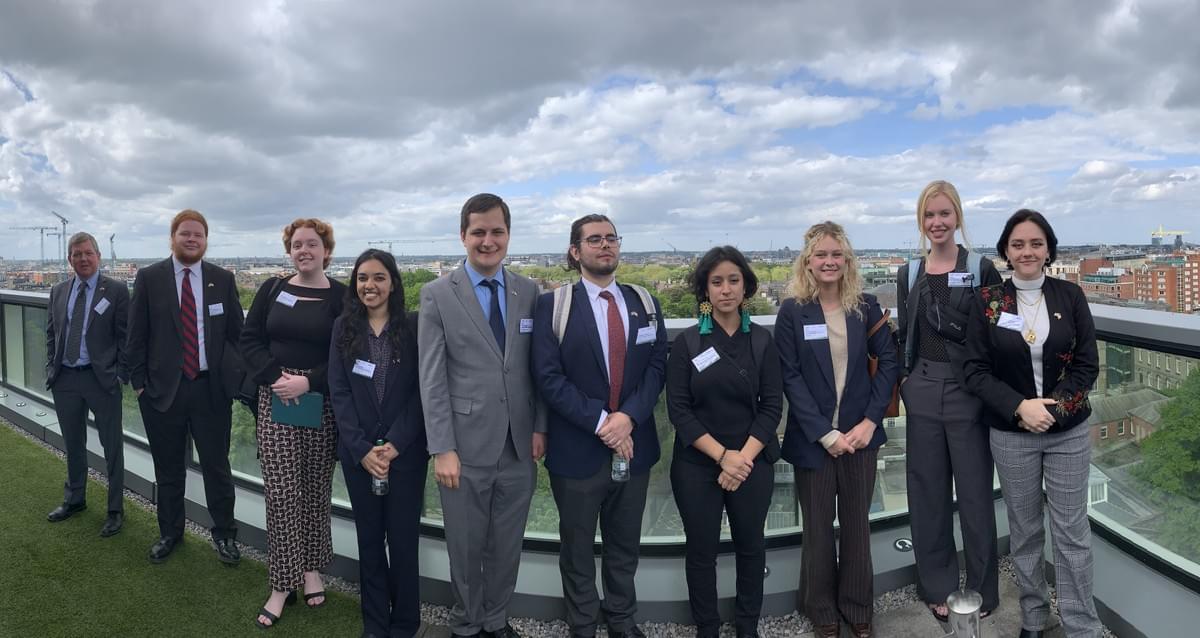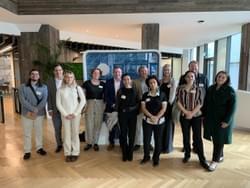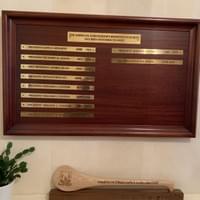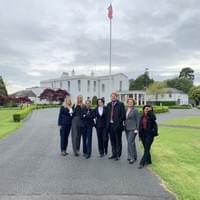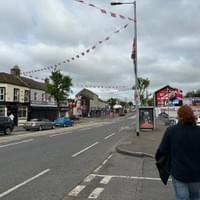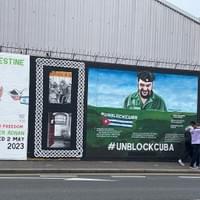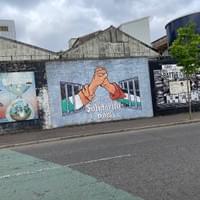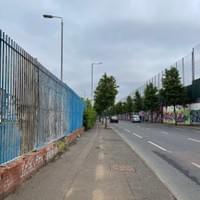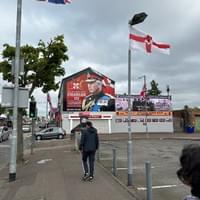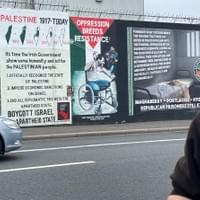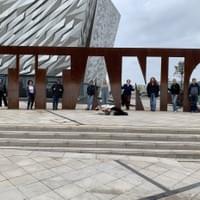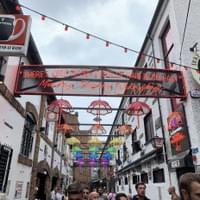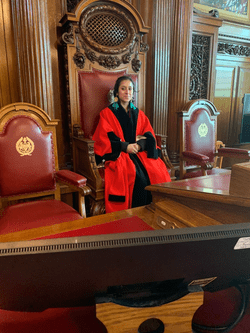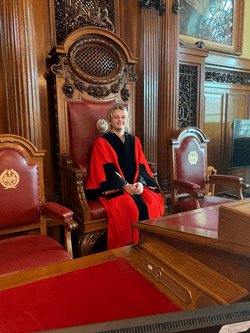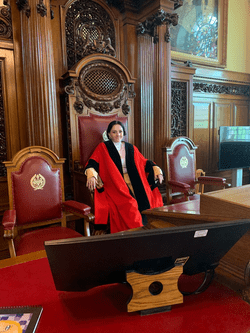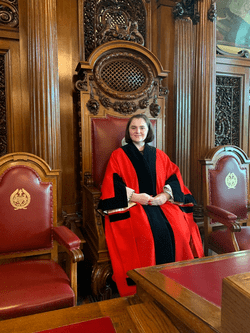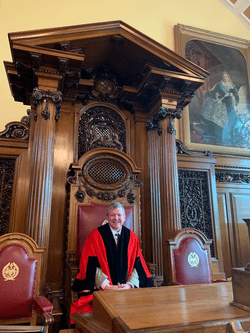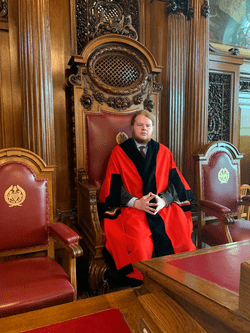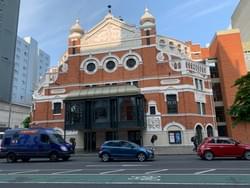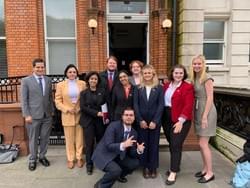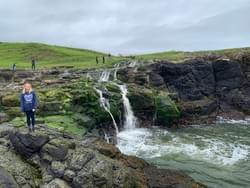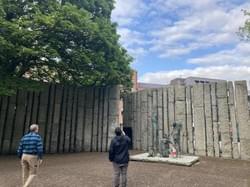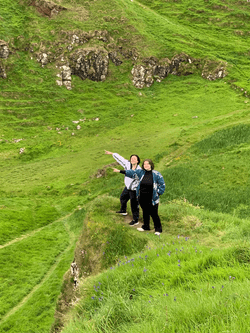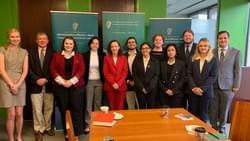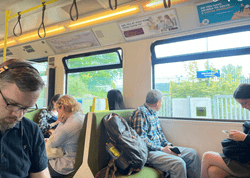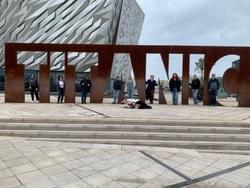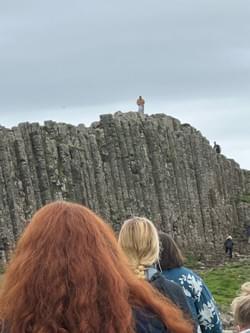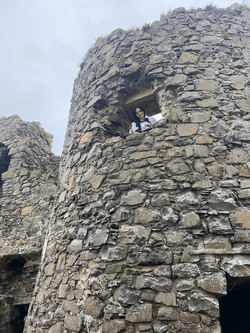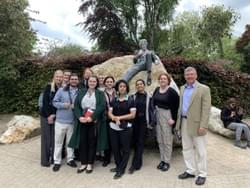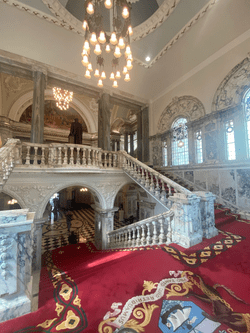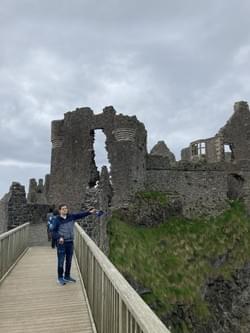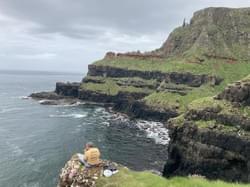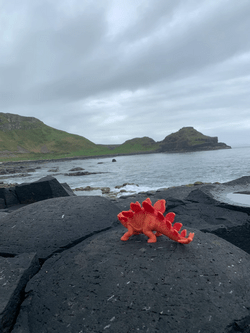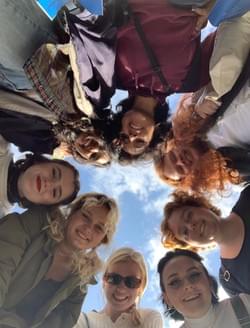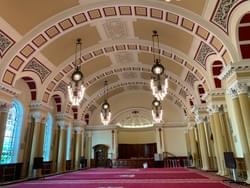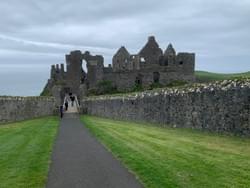
Georgia State University's 2023 Spring Break Course in Ireland
Boom, Bust, Boom and... Brexit?
Department of Foreign Affairs and Trade
Leigh Henrey
During our incredible trip to Ireland, I had the privilege of engaging in a meeting with Ireland's esteemed Department of Foreign Affairs. The encounter provided deep insights into Ireland's economic dynamics, foreign policy/engagement objectives, the implications of Brexit, the significance of soft power, and the complexities surrounding Northern Ireland's future as it pertains to its current issues within its legislature and Irish unification.
To begin, in international relations, diplomacy plays a pivotal role in shaping global affairs and fostering harmonious relationships among nations. Ireland's Department of Foreign Affairs stands as a beacon of diplomatic excellence, employing strategic approaches to navigate an ever-evolving world. Director Julie Connell of the Department of Foreign Affairs recognized outright the close ties Ireland holds with the United States through foreign direct investment and its diaspora communities. She informed us that the department introduced a 2018 Global Ireland Initiative, to try to double the Irish footprint by 2025. This initiative includes diversifying its export markets and investment following the impact of Brexit. As well as strengthening its engagement with various diaspora communities. This is valuable considering that Ireland's top contributor of Foreign Direct Investment is the United States, and its main exports are to the United States.
As we discussed the British exit from the European Union and its impact on Ireland, they mentioned the trade barriers it has imposed and the strain it has put on the Republic’s relationship with Northern Ireland. They clarified that Ireland anticipated Brexit and has subsequently protected its interests, maintained the Good Friday Agreement, and even capitalized on the opportunities that arose post-Brexit, such as strengthening Ireland's position within the E.U. We touched briefly on the 25th anniversary of the Good Friday Agreement and how Ireland's historical experiences of violence and colonization have shaped its commitment to peace and neutrality. While Ireland maintains military neutrality, it actively engages in diplomatic efforts and peacekeeping missions, underscoring its commitment to global stability. The Global Ireland Unit highlighted Ireland's firm reliance on soft power, utilizing its diaspora, cultural heritage, and E.U. membership to influence international affairs positively in contrast to the USA's hard power. We spoke about some of this soft power being exerted in the vast Irish diplomatic tours that are taken around St. Patrick's Day.
Lastly, we spoke about the current political strife within Northern Ireland with the DFA's Northern Ireland Political and Reconciliation Unit. It was mentioned that the ongoing discussions and debates surrounding Brexit have stirred conversations about Irish reunification. According to the DFA, they are currently preparing for the integration as they prepared for Brexit to occur. After arriving in Belfast following local elections, it was clear that the people of Northern Ireland, specifically the youth, have a vested interest in Sinn Fein’s progressive policies in healthcare, housing, education, and workers' rights following Brexit. They indicated a significant rise in discontent from Northern Ireland's people over the Democratic Unionist Party’s refusal to go back into power-sharing. The DUP’s refusal to govern undermines the power-sharing arrangements in Northern Ireland outlined by The Good Friday Agreement. This could exacerbate political divisions and heighten tensions between unionist and nationalist communities.
Despite this, Ireland is on the upturn and is flourishing in many aspects economically. Politically, I see Ireland on the precipice of monumental change with the rise of Sinn Fein coupled with Brexit and talk of Irish reunification.
Bord Bia
Click to see Mr. David Kennedy's presentation to the group!
Bord Bia
Olivia Berry
The meeting with Bord Bia was arguably one of the most highly anticipated of the trip. As a group, we had previously deep dived into their three-year plan and were excited to learn more about their international marketing campaigns, sustainability in Irish food production, and Bord Bia’s relationship with local Irish businesses. Bord Bia’s meeting was highly informative and David Kennedy, the Head of Dairy, gave us a great breakdown of the exportation of Irish food worldwide. We learned that Bord Bia has over 1400 client companies and over 90% of Irish dairy and meat is exported.
A few of our questions were about Bord Bia’s three-year plan, such as what their strategy was and how it was going since they were halfway through. The plan ultimately highlighted “value generation,” the idea that if people are not aware of the value of Irish food, then it will be harder to sell. In order to sell Irish food, Bord Bia’s responsibility was to develop its image which David called sustainability their “calling card” within their international marketing plan.
Irish food is distinctively valuable because it is sustainable, but this marketing tactic does not work everywhere. One of my questions was if any region stuck out as being unreceptive to their marketing tactics and David noted that the United States is one of those challenging markets. In the United States, consumers value grass-fed beef rather than sustainable beef. The product remains the same but the marketing focus changes. He also noted that many African countries prefer to purchase cattle from Ireland rather than meat already processed.
Co-leading the meeting was Michael Jacob, the Drink Sector Manager, who shared similar challenges in marketing drinks and building the quality Irish food and drink image. In the United States, for example, many Americans like Irish alcohol, but do not realize what they are drinking is an Irish product, such as Bailey’s Irish Cream and Jameson Whiskey. Interestingly, he also shared that the drink market was lacking in Ireland as there were many popular UK competitors.
The meeting was incredibly engaging and interesting and there was only a minor dip where our group was left unsatisfied by the answers. A diversity slide was presented showing that only 9% of farms are women-owned and when asked what initiatives they were pursuing to change this, they did not have a clear answer for us. I left with the general understanding from Bord Bia that increasing diversity in farm ownership was a bigger challenge than expected due to the gender dynamics in the farming industry and the generational passing down of farms to sons in particular.
As a group, we were highly prepared, engaged, and enthusiastic during this meeting. However, we lacked time to ask much about Origin Green or the situation back in January 2023 where the Bord Bia quality assurance mark was printed on French potatoes despite being for Irish food products only. Like most of the meetings we had this week, by the end we were vying for more time. Nonetheless, we learned so much about Irish food and drink in this meeting and got a sense for how widespread the goal of sustainability is in Ireland.

IDA Ireland
Click to see Mr. Tim Costello's presentation to the group!

IDA Ireland
Miguel Andia
Ireland is in a position no other country has been in, and likely no other country will be in again. Ireland, a country that is not even 100 years old, has experienced unique growth in Europe that is extremely remarkable. Historically, Ireland has been a country of two parties: Fine Gael and Fianna Fáil. While there are many similarities between the US and Ireland, Ireland does not share the extreme partisanship that seems to plague United States politics. The ability of these two parties to work together and agree on economic matters has allowed the Celtic tiger to thrive. Low corporate tax rates, an emphasis on education, and EU membership have placed Ireland in a unique position that the IDA capitalizes on.
The entire function of the IDA rests on receiving as much FDI as possible. Due to their work, the United States is Ireland's number one foreign investor. IDA client companies employ 12% of Ireland's workforce and are indirectly responsible for 20% of all employment in the Republic of Ireland. Additionally, 68% of national exports come from IDA client companies. A significant part of the IDA's job, particularly when it comes to attracting American MNCs, relies on cultural similarities shared with the United States. Having a native English-speaking population is extremely attractive to many companies. This native English-speaking factor has become even more important since Brexit, as Ireland is now the only native English-speaking country in the EU. Consequently, Ireland has become an extremely appealing gateway for companies looking to enter the EU market.
The IDA acknowledges the need to adapt to a changing world in terms of sustainability and green technology. As a government function, the IDA is committed to government-wide efforts to reduce greenhouse gas emissions (Agenda 2030). IDA client companies are responsive to green initiatives, and carbon emissions are now considered a negative factor when the IDA assesses the level of support it is willing to provide to a company. The IDA also acknowledges the pressure from private investors who prioritize sustainability initiatives. This has further encouraged companies to shift their focus towards environmental friendliness.
The wealth Ireland has amassed due to massive amounts of FDI is evident when one enters Dublin. However, what about the rest of the country? The IDA recognizes this issue and is committed to providing incentives for companies to locate outside of Dublin. Financial support is often determined regionally, and the IDA collaborates with city councils to develop the necessary infrastructure to accommodate multinational corporations. Currently, Dublin is home to 48% of all MNCs in Ireland, and one of the IDA's most challenging goals is to ensure that the rest of the country can share in the wealth created.
Due to the massive impact of the IDA on the economy, issues that affect the IDA also influence Ireland, and vice versa. IDA client companies often state that Ireland's highly educated workforce is a significant attraction. Consequently, many in Ireland believe that there should be more effort put into educational development and language learning to compete with other European countries, such as Germany. On the other hand, when Ireland faces issues like the current housing crisis in Dublin, many look to critique the IDA for their land purchasing programs. These programs involve the government purchasing land that future businesses may acquire once they move to Ireland. In our meeting with Tim Costello at IDA, it was stated that only one of these properties was deemed suitable for residential use, and the IDA fully cooperated with that assessment.
LinkedIn
Nate Burns
On May 17th, our Ireland study abroad trip had the privilege of meeting at the LinkedIn offices right there in Dublin. Built recently, the offices are gorgeous and modern, filled with cool details like indoor gardening, a music room, and a small library. Our day was jam-packed with an extensive tour and a quick chat with Sharon McCooey (Head of LinkedIn Ireland) which was very informative as well, but we primarily met with Dr. Sein O Muineachain and Kate O’Sullivan, respectively discussing Ireland's political economy and LinkedIn’s plans for further expansion into Europe.
While brief, Sharon McCooey took time out of her busy schedule and came to talk to us primarily about what LinkedIn is like as a company. One thing she mentioned that stuck with me was how much LinkedIn is focused on supporting its employees, helping them improve their skills so they can move onto that next job. She also talked about founding LinkedIn’s Ireland offices, growing from initially three employees to about 2,300 nowadays.
Next, our chat with Dr. O Muineachain, who insisted we just call him Sein (pronounced like Shane), was enlightening with his insider’s look at the Irish political economy. Sein works primarily as the manager for LinkedIn’s Economic Graph tool, which uses data from the company to show what they claim is a real time representation of the economy. With access to data about jobs, skills of workers, education, the Economic Graph is a rigorous tool that LinkedIn has worked with policymakers in government on using to their advantage. LinkedIn’s unique position, as Sein explained, was that their site literally is built around tracking this kind of data and data about companies. Taking that and formulating the Economic Graph, the program focuses on macroeconomic trends, equity, and skills in the economy at any given time. Rightfully so, LinkedIn and Sein were very proud of their tool they’ve built and it seems crucial to helping understand the economy. However, Sein also brings with him the unique perspective of being on the South Dublin County Council, a representative of the Fianna Fail party. This direct view into local scale politics and what perspective he could offer on greater Irish politics was enlightening, and interesting to hear about. One of the big takeaways that I had from this discussion and something he hammered home was the stability of Irish politics. Two of the big parties, Fianna Fail and Fine Gael, Sein explained, were very similar in policy but mostly differed in the makeup of their constituencies . These two parties were dominant in the country for a while until recently, with the rise of the left-wing Sinn Fein party. Combining knowledge and experience from both his groundbreaking work at LinkedIn and his involvement in local politics, Sein offered a unique and fascinating perspective into both of these areas and was a joy to talk to.
But the fun didn’t stop there, as we also met with LinkedIn’s EU Public Policy director Kate O’Sullivan. Our discussion focused on LinkedIn’s expansion into Europe but also more about the European Union as a whole and its effect on Ireland. She explained that the policy teams work on two things overall. These are sharing data insights pulled from the LinkedIn Economic Graph that Sein discussed with us, and talking to the government about tech regulation. The Economic Graph, as Kate explained, has unique data insights that governments don’t have and dynamic data that is constantly updating from LinkedIn’s own data. LinkedIn works with governments through the public policy team to share these insights on policy topics that it shares a mutual interest with. The other half, tech regulation in the EU, is something that LinkedIn is deeply interested in. Something that stuck out to me when we discussed tech regulation with LinkedIn and Kate was that LinkedIn really really wants to have a clear set of rules that they can stick to when dealing with tech. Regulation as of right now is very much a no man’s land, and LinkedIn wants a concrete set of rules for them to follow in respect to tech in the EU. Another interesting point was because of the country of establishment principle (which is about companies with where their headquarters are rather than where they were founded), Ireland is the lead on digital security in the EU because of the density of tech companies in the small country. Finally, the last point I found interesting in our discussion was the EU adoption of civil law rather than common law, where laws can be written out and changed without needing precedent. That, with the impending tech regulations, means that LinkedIn has a lot to keep an eye on in the European Union.
Overall, our visit was very informative and interesting, and we’re incredibly grateful to be given the opportunity to spend the day with LinkedIn.
Institute of International and European Affairs
Institute of International and European Affairs
Rachel Braddock
On May 18, 2023, our group traveled to Ireland’s primary international affairs think tank, the Institute of International and European Affairs (IIEA), to engage in conversation with several researchers including Dr. Barry Colfer, the Director of Research at IIEA. Dr. Colfer began the meeting by asking each student what they are curious to know about Ireland and its political economy. In the conversations, Dr. Colfer shared that Ireland is a “soft power superpower.” Essentially, this means Ireland achieves its international goals through influence and diplomacy rather than war and harsh economic sanctions that “hard power” countries implement. Dr. Colfer also expressed a modern perspective on Irish emigration by saying, “We raise our children like cattle for export.” It is clear many Irish people immigrated to the United States during the famine and for many years following that, but his quote suggests people are still Ireland’s largest export around the globe.
Following Dr. Colfer’s introduction was Senior Researcher, Daire Lawler’s conversation about the problems Ireland is currently facing. Lawler dove more into the housing crisis that we read about before the trip. He shared that Ireland had about 1 billion euros left over in the housing budget due to the local government objecting to planned construction projects, but also shared that Irish people tend to have an “obsession with owning” when it comes to property. It’s a cultural instinct that reinforces the “Irish dream” despite the current income and housing disparities. Since people are struggling to buy a home two main things are happening. The first is renting becomes the only answer so properties are being built with renting in mind, instead of building to own. Second, remote work and the ability to commute have caused a larger demand outside of major cities like Dublin instead of increasing demand in the city center. Lawler shared a great knowledge of a wide variety of topics. Later the same evening, we saw him interview US Ambassador Claire D. Cronin on her mission while in Ireland and how the US-Ireland relationship can grow stronger.
Following Lawler’s discussion was a UK/Brexit Researcher, Aislinn McCann’s time to discuss Northern Ireland, the Windsor Framework, and other general Brexit concerns. McCann’s perspective, in addition to Katy Hayward’s presentation at Queen’s University Belfast, on the discussion was vital for the overall theme of the trip, especially since she was raised in Northern Ireland. Of the many things she shared, what shocked me the most was the Democratic Unionist Party (DUP) being left out of the Windsor Framework discussions despite its alliance with Britain. Since then, the DUP has refused to return to the government at Stormont until they establish a new customs agreement. When Ms. Hayward discussed this, she did not expect the pause at Stormont to be detrimental to the party’s reputation, but later agreed that this hold will be ineffective for democracy if it lasts for an extended period. On a lighter note, Ms. McCann promoted Northern Ireland and Ireland’s relationship by admitting a shared culture despite its current disunity.
Cian FitzGerald, Security, and Defense Researcher was our final speaker at IIEA. Mr. FitzGerald discussed the upcoming forums happening in local communities in June 2023 about dismantling the triple lock when it comes to military neutrality for the Russia-Ukraine war, but importantly, displayed a strong concern for Ireland’s lack of military. Essentially, the dilemma is that Ireland spends a small amount on defense and its defense technology is from World War II. If the forum supports dismantling the UN Security Council aspect of the triple lock, the parliament and cabinet still need to approve of any action. However, undersea cables need to be protected, cyber-attacks need to be avoided, and strategies other than “shoot n scoot” need to be implemented. Unfortunately, Mr. FitzGerald admitted that Ireland would be a rather easy country to invade, especially since it is not a part of NATO. Along with the housing crisis, I would consider defense to be one of Ireland’s most critical issues. Although it is a country that focuses on innovation and economic strategy, a weak defense can potentially destroy all of Ireland’s efforts on the world stage.
Enterprise Ireland
Click to see Ms. Katie Ahern's and Mr. Jim Barry's presentation to the group!
Enterprise Ireland
Ishani Datta
The Irish economy is a riveting amalgamation of resilience, innovation, global synchronicity, and connection. Notable for its remarkable turnaround, Ireland has surfaced as one of Europe’s fastest-growing economies. Over time, Ireland has auspiciously transitioned from a heavily agrarian-based economy to a multifaceted and highly developed knowledge-driven economy, focusing on its favorable business environment, affirming position within the European Union, educated workforce, and specialty in agrifood, high tech, and life sciences. Enterprise Ireland recognizes that the Irish economy prospers in several sectors such as finance, manufacturing, pharmaceuticals, and most importantly technology. Ireland is also exceptional at attracting multinational corporations and upholding a dynamic entrepreneurial spirit, in which Enterprise plays a significant role. Additionally, Enterprise and Ireland’s commitment to trade and investment, accompanied by a strong emphasis on research, development, innovation, and sustainability, has bolstered the nation’s position as a leading player in the global market.
Enterprise Ireland functions as a national development agency that is accountable for supporting Irish businesses in reaching their full growth potential and “breaking into global markets” as noted by Katie Ahern, a Development Executive with a focus in strategic policy at Enterprise. The primary objective of Enterprise Ireland while performing under the Department of Enterprise, Trade, and Employment is to create a beneficial environment for Irish companies to compete in, which in turn contributes massively to Ireland’s economic growth and job formation.
During our meeting with Katie Ahern and Jim Barry whose work contributes massively to the success of Enterprise as an agency, we learned about the large range of services and methods of support given to Irish businesses which exist across diverse sectors. These supports are effectively tailored to address many barriers to the success of Irish businesses. Enterprise Ireland is known to be Europe’s largest venture capital fund. As of today, Enterprise spans twenty-four different countries with nearly fifty standing offices. While these numbers do not compare to larger nations, for a country the size of South Dakota in the United States and a mere population of 5 million, these figures are impressive and are largely the reason why Ireland has reached its level of success. The Enterprise team has acknowledged that the lack of physical office locations has impacted engagement, but there are efforts to resolve this issue. In fact, in the past few years, the number of global locations has risen from 30 to 50 with an outreach that is also much larger. South America has the least number of offices and therefore generates less in revenue than North America and Europe. Enterprise “has a vision to find solutions to global challenges” and mainly provides aid in grants, equities, and knowledge of incentives.
With an internal focus, Enterprise Ireland has acknowledged its partners in fostering economic growth such as Bord Bia and IDA. They have noted that there is no presence of competition between these agencies even though they deal with similar issues. There is a cohesive element to these agencies as they all focus on their respective roles. Enterprise analyses businesses known as “High Potential Start Ups” which have the potential to create 10 new jobs and bring in 1 million in sales within 3 years. They specialize in providing plans for businesses Post-Brexit that deal with new market opportunities and market entry outside of the UK. The heavy emphasis on sustainability provides penalties and incentives for Irish businesses. This commitment to sustainability includes a 2% penalty on a company’s annual revenue for non-compliance in regard to Enterprise’s policies.
Due to the focus on crisis response, the green transition, and digital transition, Enterprise has proven itself to be an integral part of Ireland’s currently booming economy and recovery from its bust period.
Moderated Discussion with US Ambassador Cronin
Mason Ward
Meeting with the US Ambassador to Ireland, in a way, represented the culmination of everything we had learned up to that point in the course.
The Ambassador’s Residence, or the Deerfield Residence, is steeped in history and tradition. Before we even got to the residence, we had to drive through the enormous green space that is Phoenix Park, passing by the President of Ireland’s official residence along the way. There was a long path that wound its way from the front gate to the residence proper, past the multiple golf holes dotting the vast estate. There were at least two busts of past American presidents, one of Abraham Lincoln facing the front door and one of John F. Kennedy back out along the path.
One of the first things I noticed inside of the residence was a plaque bearing the name of every sitting US President to visit Ireland, and pictures of Joe Biden’s recent visit were scattered throughout: we learned that he spent a few hours here on his diplomatic tour. We spent some time mingling with other guests, brought along by the organization that had invited us to this event in the first place, the IIEA, and enjoying the atmosphere before the ambassador herself appeared.
Our tour of the residence, led by Ambassador Cronin herself, began in the Red Room, which was described as the most “normal” room in the house, where the ambassadorial family would relax and ‘watch Netflix.’ While there, we were told about the ‘Open Doors Initiative,’ whereby students would be brought in to do exactly what we were doing, seeing the Deerfield Residence and speaking with Ambassador Cronin. At that point, I believe, it was stated that some 2000 students had already participated in this initiative. In the main room of the residence, we were told that US diplomatic missions could select and display particular works of art. We discussed one such artwork displayed there, a portrait of Frederick Douglass. We heard an anecdote about how, stepping foot in Ireland for the first time, he remarked that it was the first time he’d felt truly free.
We moved from there to the ballroom, where we got into the most substantive portion of the meeting, with one of the hosts from our meeting with IIEA that morning serving as moderator. Various topics were discussed, touching on many areas of the US-Irish relationship and including a fresh perspective on some of the issues raised in the earlier meeting. The economic relationship between the two nations, for instance, was discussed, with the US being noted as the number one contributor of FDI to Ireland and Ireland being the ninth-largest contributor of FDI back to the United States. Also discussed were Ireland and the United States’ shared values, including commitments to democracy and human rights. In this context, the Russian invasion of Ukraine was unequivocally condemned. In the next portion of the discussion, Ambassador Cronin’s political background was brought up.
In particular, she worked on reforming Massachusetts’ criminal law through her work on the judiciary committee of the Massachusetts state legislature. An interesting point in the discussion, somewhat tied to this, was centered on the US aiding Ireland in combating Irish organized crime, which I was previously unaware of as an issue in Ireland. The audience then had the opportunity to ask questions. One interesting question centered (rather unsurprisingly) around issues with the US immigration system and the J-1 visa, while another, unexpectedly, had to do with music. Following this, we were all herded out again into the main room, where a group photo was taken. A few of us, the GSU students, made our way outside and congregated around a bust of President John F. Kennedy. This was rather sad in retrospect, given that we also heard about how President Kennedy had the desire to be the US Ambassador to Ireland himself after finishing his presidential career.
Afterwards, IIEA invited us to a pub called the Hole in the Wall, which was only about a ten-minute walk from the Ambassador’s Residence. There, we continued to have informal dialogues with fellow students and young adults from Ireland about all manner of issues that wouldn’t necessarily have fit into one of our more formal meetings, such as whether there was an Irish equivalent of Bigfoot!
Belfast, Northern Ireland
Jasmine Munoz
While in Belfast, our group took two mural tours led by ex-political prisoners. The murals were largely created after what is widely known as The Troubles—a violent period of political and social upheaval in Ireland’s Ulster region. In short, the Troubles was a complex period of conflict from 1969 until 1998. It is often presented as a religious dispute between Catholic and Protestants but has many more layers and origins that date back to the English settling in Ireland. Along with divisions between Catholics and Protestants were divisions between Unionists and Nationalists, and Republicans and Loyalists. Protestants tend to be Loyalists who want Northern Ireland to remain a part of the United Kingdom. Catholics tend to be Republicans who seek a united Ireland and separation from the United Kingdom. However, the issue is too complex for these to be true for every individual. We toured with a Loyalist and with a Republican. While we remained in the same general area, the two tour guides gave significantly different accounts.
Once we walked through the high fence into the Protestant community, their affiliations were immediately apparent. UK flag banners were strung from lamppost to lamppost. Flags commemorating the King’s coronation were flown in front of houses. Most notable was a pair of large murals—one a memorial of the late queen and the other of the new king. Our tour guide argued several points contrary to what we heard from some of our other meetings. He believes that the Democratic Unionist Party will not return to Stormont and that democratic elections are the only means of restoring peace. He also argued that the goals and benefits of Brexit lie in immigration policy instead of issues with the supranational powers of the EU. One of the loyalist’s main points was that many people wish to stay in the United Kingdom for the healthcare system. In short, he discussed the Troubles predominantly from a religious perspective. If he functions as an accurate representation of the Loyalist community, then Sinn Féin and the IRA are interchangeable and viewed as a single enemy.
On the other hand, the tour guide who walked us through the Catholic area had a different approach. One of his first points was that the division should not be considered only religious. He spent a significant portion of the tour emphasizing the precision of language that he believed should be used to discuss Ireland’s issues. The first term he disputed was ‘the Troubles’. He argued that this was diminutive and reduced what was in effect a complex, vicious civil war into a less serious difference of religion. Because the Queen Victoria was exporting food that was more than sufficient to feed the population, he referred to the famine as genocide. He also was against calling the southern regions the “Republic of Ireland” because it legitimized the UK’s manipulation of Ireland. This tour guide participated in the five years of protests by Republican prisoners, and he shared stories of their experiences. His recounts of the prison’s response to the no-wash protest were especially harsh—undiluted cleaning chemicals were sprayed into cells, prisoners were forcibly bathed and scrubbed with deck brushes, and humiliation and assault were commonplace.
Even though each guide had a distinct approach to sharing their experiences, both utilized a similar tactic. Many of the murals covered a foreign affair, but depending on which side of the wall you were on, a different side is favored. An example of this is the murals about the Israel-Palestine conflict. On the Republican side, murals show solidarity with the struggle of Palestinians and support their cause. On the Loyalist side, murals favor Israel and show solidarity between Israel and Great Britain. The murals are updated to reflect changes and reinforce support. The general takeaway from the two tours was that even though 25 years have passed since the Good Friday Agreement, the situation has not been completely remedied and tensions remain in daily life.
Queen's University, Belfast with Professor Bryan
Click to see Prof. Dominic Bryan's presentation to the group!
Queen's University, Belfast
by Siobhan Mullins
When I decided to go on a study abroad program to Northern Ireland to immerse myself in its culture, I did not expect to learn so much about it in a university classroom. Luckily, I was proven very wrong. While in Belfast, Northern Ireland, the study abroad group was privileged to meet with two professors at Queen’s University Belfast, one of whom was Dominic Bryan. Dr. Bryan has been a professor of anthropology at QUB for nearly 24 years and has researched symbols, rituals, and the overall dynamic culture of Northern Ireland. His lively lecture and immersive learning allowed us to make sense of the country’s culture and conflict over the past few decades.
Dr. Bryan pushed us to question our understanding of the nation’s holistic identity. Or does it even have one? And if it doesn’t have its own identity, can it even be called a nation? Dr. Bryan opened our minds up to a brand-new understanding of what it means to be a nation. He explained to us that nearly all nations that have ever come into existence do so emotionally. A nation is glued together by the story told by its people. Every nation has a story of martyrs who die for it, a flag to represent it, statues erected, and anthems written. All of these symbols tell the story of a greater identity that unites all. Northern Ireland certainly is part of a country, Dr. Bryan argues, but not a nation. Northern Ireland’s existence came about by an agreement between the Irish and the British. The states were manufactured. So, how then does Northern Ireland’s lack of identity manifest today?
This question has led to a substantial division between the Protestants and Catholics. But make one thing clear: this divide is hardly religious. He argues that these two identities - not cultures but identities - look quite similar. Therefore, the groups go to great lengths to distinguish themselves from one another. Dr. Bryan discussed how this is done through the use of flags and parades. The typical tri-color Irish flag is starkly contrasted with that of the U.K. flag. Both flags are hung in respective unionist and loyalist areas to mark their respective territories. Flags are used so often that Dr. Bryan argues they are even starting to lose their value. In his research, he found that more flags manufactured and produced cheaply contribute to the symbol losing its sacredness. All of this jumbles Northern Ireland’s identity even more.
Another identity marker used in Northern Ireland is the parades. Dr. Bryan explained that parading in Northern Ireland has been a cause for controversy. Historically, loyalists have most commonly paraded in Belfast and heightened tensions by parading through unionist neighborhoods. A name can also conjure up preconceived notions and wary, since names might give away Protestant or Catholic roots. Wherever you grow up in Northern Ireland, it is a given that you learn to locate, read, and identify all of these markers.
One of the biggest personal takeaways from our meeting with Dr. Bryan was our detailed discussion of cultural identity, specifically, that of Irish Americans. He argued that culture is invented out of inspiration by others rather than a mesh of multiple cultural identities. So being Irish American is not a mix, per se of American and Irish culture. This is not to say
Irish American culture is inauthentic; however, it is a culture of its own. This especially stood out to me, as an American girl whose grandparents were Irish immigrants. The idea of Irish identity has quite literally been given to me in my name, Siobhan. It was a unique and enlightening take on the idea. My culture is not inauthentic and certainly not unimportant, but it is distinctly different from that of someone born and raised in Ireland. The same goes for that of someone born and raised in Northern Ireland. At times, it may be difficult to make sense of the ongoing tensions but that is because many of us have no idea what it is like to live in this country. Dr. Dominic Bryan allowed us the opportunity to humanize and dissect what it means to be Northern
Irish. Through all the prosperity and hardship, through all the victories and violence, one thing is clear: Northern Ireland is still working very hard to find its identity as a nation.
Queen's University, Belfast with Professor Hayward
Click to see Prof. Katie Hayward's presentation to the group!
Queen's University, Belfast
by Evelyn Lowry
After ten days of immersive education in Dublin and Belfast, our group traveled to Queens University Belfast, in Northern Ireland. Our conversation with Professor Katy Hayward of Queen's University Belfast gave us incredible insight into the inner workings, complications, and implications of Brexit. Having the wonderful opportunity to learn from Katy Hayward, a professor of Political Sociology at QUB, and internationally recognized expert on Brexit as well as the border between the Republic of Ireland and Northern Ireland, was an incredible way to wrap up our education in Ireland.
“Brexit means borders” - a phrase of Dr. Hayward’s which has remained on my mind. It has been seven years since the referendum which brought Brexit to reality, and Northern Ireland has certainly faced the most substantial consequences because of this historical decision. At the birth of Brexit, members of the British government did not know what Brexit truly meant in practice - how would Brexit come to life and what would it really mean for those involved?
Professor Hayward spoke to us about the “cornerstones of Border management”, a cycle of conditions, all of which need to be met and the things which make those requirements possible. One, knowing what is crossing the border, which consists of paperwork processes. Two, knowing that what is crossing the border meets proper criteria, through implementation of checks and presence of infrastructure. And three, knowing that entry through a border is conditional and preventable. An Eisenhower Fellow, Dr. Hayward shared with us that she had conducted research about border management by using the United States as an example of how to utilize technology to control a border, as the country has done this for its borders with Mexico and Canada. A key finding was that information is absolutely necessary for border management, and infrastructure such as checkpoints, guards, and technology are essential to manage if something is not meeting border requirements.
In terms of Brexit, Dr. Hayward outlined the “trilemma” - leaving the E.U. single market, avoiding a border between Northern Ireland and Great Britain, and additionally avoiding a border between Ireland and Northern Ireland. From this trilemma, the Northern Ireland Protocol was created, creating a trade border in the Irish Sea. This has become a major point of contention in Northern Irish politics and has led to the Democratic Unionist party of Northern Ireland boycotting governmental power-sharing and functioning at Stormont.
A major takeaway from this meeting with Dr. Hayward was learning about Article Eighteen of the Northern Ireland Protocol, designating that Articles Five to Ten of the N.I.P. will be put to a vote in front of the Northern Ireland Assembly, Stormont, in late 2024. This vote will decide if the articles will be negotiated by the U.K. and E.U., or if they will continue to stay the same. However, how will this work if the D.U.P does not return to power-sharing at Stormont? Dr. Hayward explained to us that the articles will still be put to a vote. Interestingly, the articles require that if only a simple majority of one-party votes to reaffirm or rewrite, and the vote is not ‘cross-community’, then another vote must take place four years ahead. If Articles Five through Ten of the Northern Ireland Protocol are voted down in 2024, they are to be rewritten by the U.K. and E.U. to rewrite– it is necessary to recognize that once again, Northern Ireland is not part of this central discussion. For change to be made to the Northern Ireland Protocol, whether it be to reaffirm or rewrite the presented articles, it is necessary that there is a cross community vote.
We touched on the possibility of reunification in our discussion with Dr. Hayward. If reunification occurs, the Northern Ireland Protocol will no longer apply, all 32 counties of Ireland and Northern Ireland will be part of the E.U. Through 2022 opinion polling, Dr. Hayward showed us that an increasing number of people think that the existence of a United Ireland is more likely than the United Kingdom in twenty years' time. Additionally, sixty-three percent of respondents believed that Brexit made a United Ireland more likely. Dr. Hayward noted that current and future conversation and debate of a united Ireland must acknowledge the growing diversity of Ireland, stating that it looks incredibly different than it did a decade ago.
Created in response to boycott over the Northern Ireland Protocol, The Windsor framework is not a rewritten protocol, but rather a reinterpretation of the legal text provided in the Protocol. The agreement is an example of commitment to ‘mutually agreeable solutions”. Through the introduction of a red lane and green lane system, goods prohibited in the E.U. can be sold in Northern Ireland. The green lane is designed for retail and agrifood from Great Britain to be easily attained and sold in Northern Ireland. The Windsor Framework was designed to bring an end to the D.U.P.'s boycott of power sharing and involvement in government at Stormont. In recent local elections, The D.U.P. maintained the same number of seats in government, and the party sees the results as vindication of their boycott approach, and their messaging that the Northern Ireland Protocol undermines the Union. How will the implementation of the framework affect both the future of Stormont in Northern Ireland, and chances of a united Ireland?
I am eager to see if the return of power sharing will come to the Northern Ireland Assembly, and how the future of the border will unfold following implementation of the Windsor Framework, in conjunction with increasing discussion of shared Ireland Initiative. Our conversation with Dr. Hayward was incredibly thought-provoking and insightful, and I was left with a much broader understanding of how Brexit truly does mean borders.
Gallery of Our Adventure





